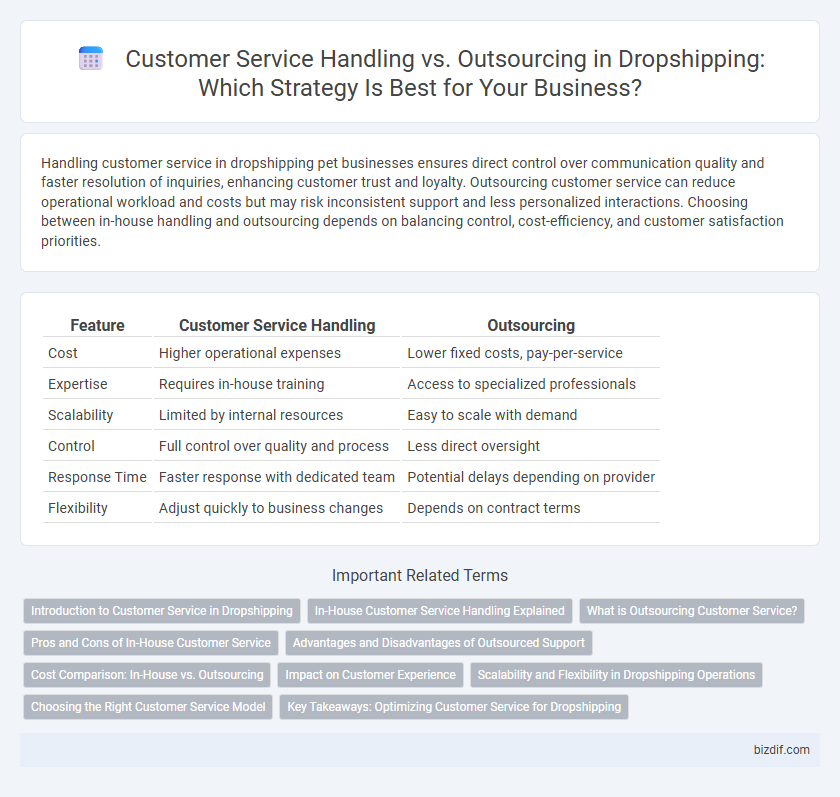Handling customer service in dropshipping pet businesses ensures direct control over communication quality and faster resolution of inquiries, enhancing customer trust and loyalty. Outsourcing customer service can reduce operational workload and costs but may risk inconsistent support and less personalized interactions. Choosing between in-house handling and outsourcing depends on balancing control, cost-efficiency, and customer satisfaction priorities.
Table of Comparison
| Feature | Customer Service Handling | Outsourcing |
|---|---|---|
| Cost | Higher operational expenses | Lower fixed costs, pay-per-service |
| Expertise | Requires in-house training | Access to specialized professionals |
| Scalability | Limited by internal resources | Easy to scale with demand |
| Control | Full control over quality and process | Less direct oversight |
| Response Time | Faster response with dedicated team | Potential delays depending on provider |
| Flexibility | Adjust quickly to business changes | Depends on contract terms |
Introduction to Customer Service in Dropshipping
Effective customer service in dropshipping directly impacts brand reputation and customer retention by addressing inquiries, processing returns, and resolving order issues efficiently. Handling customer service internally provides greater control over communication quality and brand messaging but demands dedicated resources and training. Outsourcing customer service offers scalability and cost savings by leveraging specialized teams, though it may introduce challenges in maintaining consistent brand voice and responsiveness.
In-House Customer Service Handling Explained
In-house customer service handling in dropshipping allows direct control over communication quality and brand consistency, ensuring personalized support tailored to specific products and customer needs. Employing dedicated staff facilitates immediate problem resolution, strengthening customer trust and loyalty while maintaining confidentiality of sensitive data. This approach often results in faster response times and better integration with internal operations compared to outsourcing customer service functions.
What is Outsourcing Customer Service?
Outsourcing customer service involves delegating support tasks to external agencies or third-party providers specialized in managing customer inquiries, complaints, and technical assistance. This approach enables dropshipping businesses to access trained professionals, reduce operational costs, and maintain 24/7 support coverage without expanding in-house teams. Effective outsourcing partners leverage advanced CRM tools and multilingual support options to enhance customer satisfaction and streamline resolution times.
Pros and Cons of In-House Customer Service
In-house customer service for dropshipping enables direct control over brand communication and quality assurance, fostering personalized interactions that can enhance customer loyalty. However, it requires significant investment in hiring, training, and managing staff, which can increase operational costs and strain resources. Limited scalability and potential for resource diversion from core business functions are additional challenges faced by businesses maintaining internal support teams.
Advantages and Disadvantages of Outsourced Support
Outsourced customer service in dropshipping offers cost-effective scalability and access to specialized support teams, enhancing response times and multilingual capabilities. However, it may lead to reduced control over service quality, potential communication barriers, and a less personalized customer experience. Businesses must balance these advantages with challenges like data security risks and dependency on third-party providers to maintain brand reputation.
Cost Comparison: In-House vs. Outsourcing
In dropshipping, in-house customer service demands significant investment in hiring, training, and maintaining support staff, often resulting in fixed monthly costs. Outsourcing customer service offers scalable pricing models with variable costs aligned to call volume, potentially reducing overall expenses and freeing resources for core operations. Companies should analyze the total cost of ownership, including technology, management, and service quality, to determine the most cost-effective approach.
Impact on Customer Experience
In dropshipping, direct customer service handling allows for personalized and consistent communication, fostering greater trust and brand loyalty by swiftly addressing customer concerns. Outsourcing customer support can lead to faster response times due to specialized teams, but may risk misalignment with brand values and diminished customer satisfaction if poorly managed. Balancing in-house expertise with outsourcing efficiency directly impacts the overall customer experience, influencing repeat purchases and positive reviews.
Scalability and Flexibility in Dropshipping Operations
Scalability in dropshipping operations hinges on efficient customer service handling, where insourced teams provide direct control and immediate adaptation to order volume fluctuations. Outsourcing customer service introduces flexibility by leveraging specialized providers with scalable resources, accommodating seasonal demand spikes without increasing permanent overhead. Balancing in-house management and outsourced solutions ensures dropshipping businesses maintain responsiveness and cost-efficiency during rapid growth phases.
Choosing the Right Customer Service Model
Choosing the right customer service model in dropshipping hinges on balancing control, cost, and quality. In-house customer service provides direct oversight and brand consistency but requires investment in training and infrastructure, while outsourcing offers scalability and reduced expenses with potential risks in communication and service quality. Evaluating factors such as order volume, customer expectations, and budget constraints ensures the optimal approach to maintaining customer satisfaction and operational efficiency.
Key Takeaways: Optimizing Customer Service for Dropshipping
Optimizing customer service for dropshipping hinges on balancing in-house handling with strategic outsourcing to ensure scalability and cost efficiency. In-house teams provide direct control and faster issue resolution, while outsourcing leverages specialized expertise and 24/7 support capabilities. Key performance metrics like response time, customer satisfaction score (CSAT), and resolution rate should guide the decision to enhance overall customer experience.
Customer Service Handling vs Outsourcing Infographic

 bizdif.com
bizdif.com